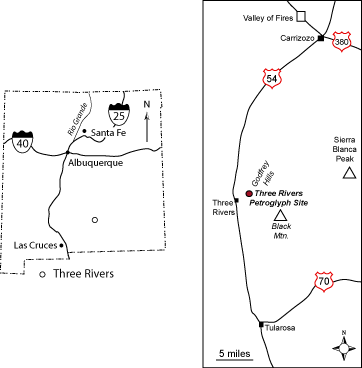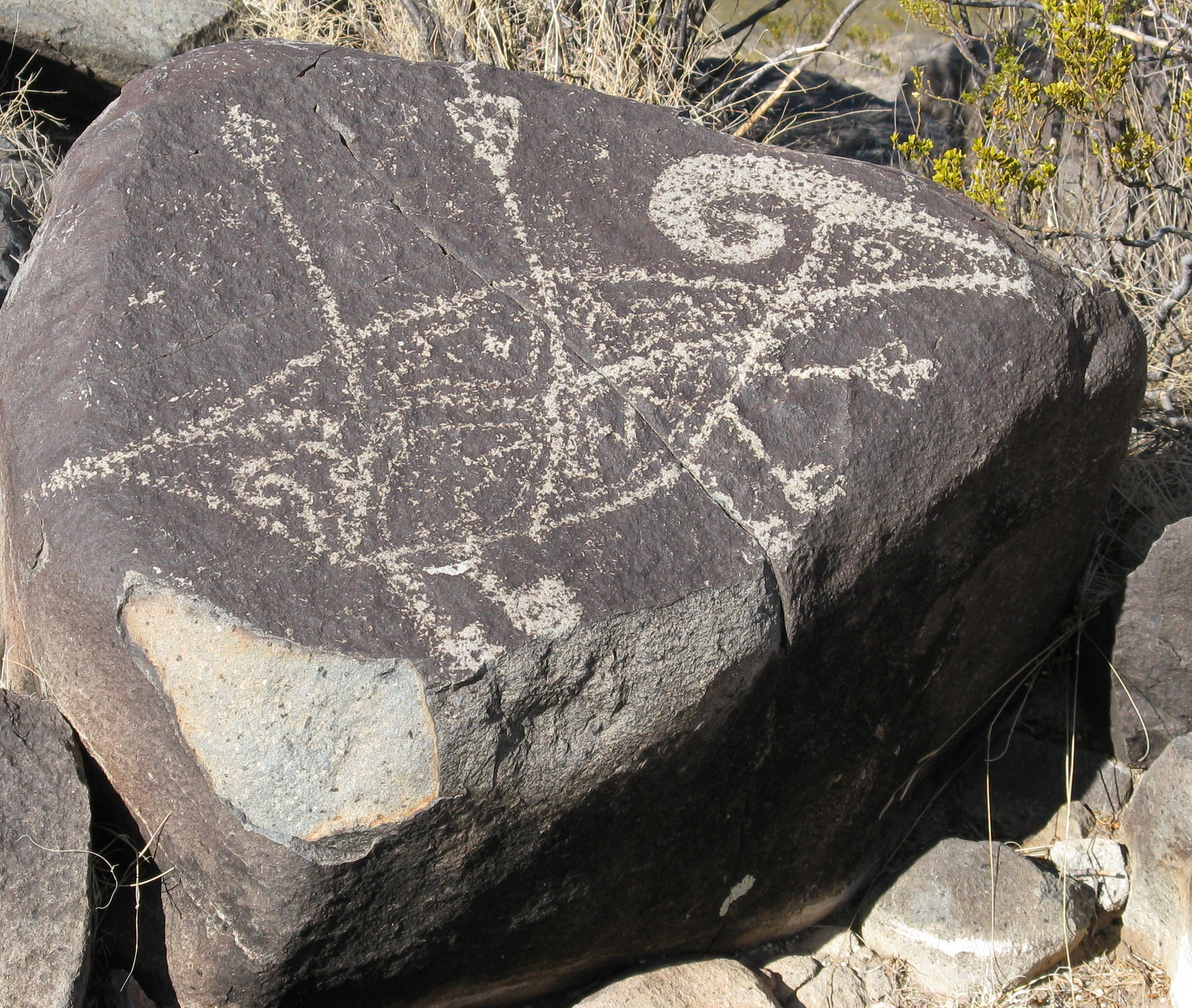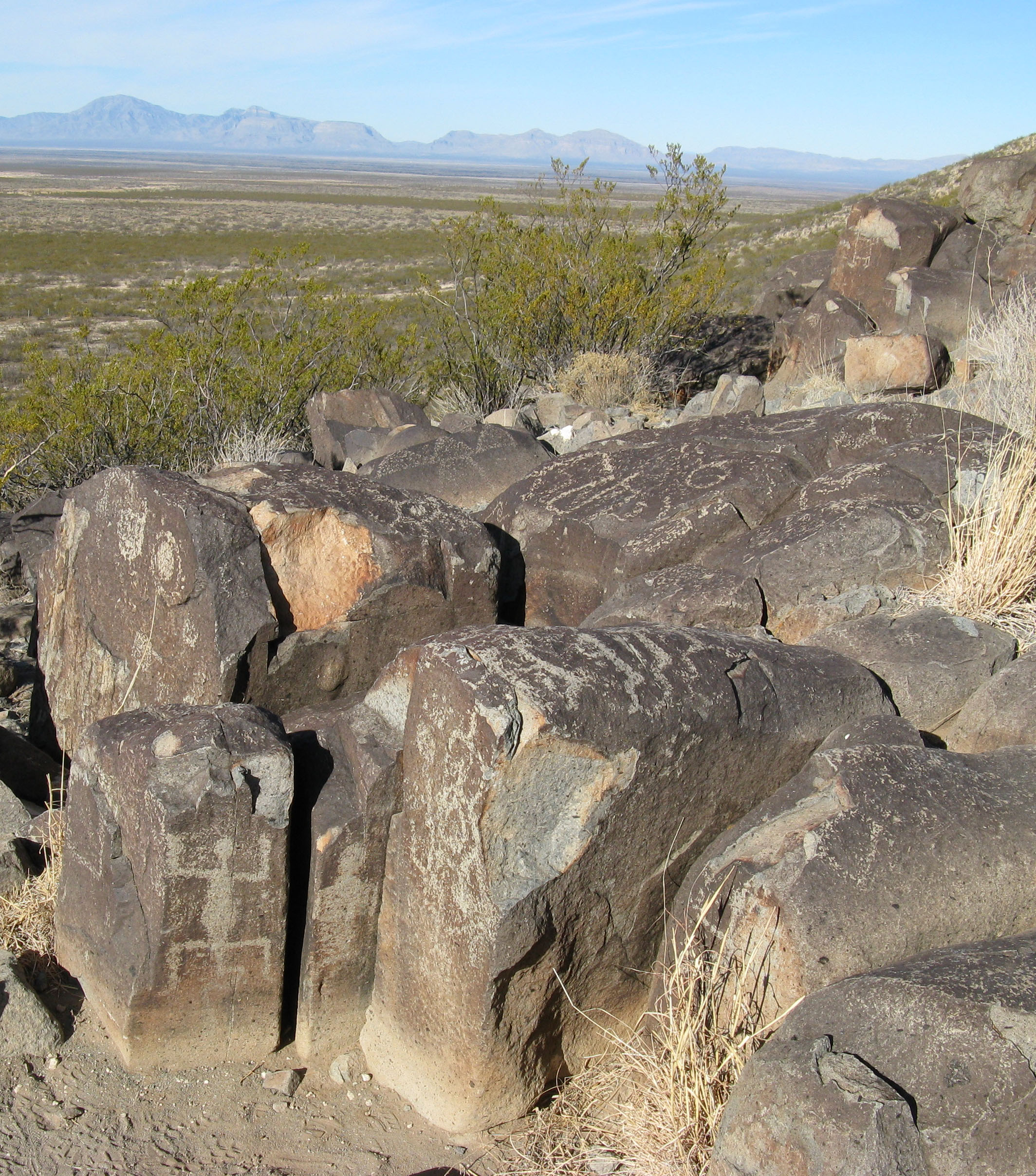
Three Rivers Petroglyph Site
Location

The site is 17 miles north of Tularosa and 28 miles south of Carrizozo (Figure 1). Turn east off of U.S. Highway 54 at the sign for Otero County Road B-030 (Three Rivers Road) in the community of Three Rivers and drive about 4.6 miles to the parking lot on the north side of the road. The Bureau of Land Management manages the area. The area features hiking trails and a picnic area. The Godfrey Hills form the low hills to the northeast of the site. Black Mountain lies to the southeast.
Introduction
The locale is called Three Rivers because Indian Creek, Golondrina (“Swallow”) Creek, and Three Rivers come together near the site (McLemore, 2002). Native Americans originally occupied the site about 10,000 years ago. The descendants of the early occupants were the Jornada Mogollon Indians, who inhabited the region 900 to 1400 AD. The Jornada Mogollon Indians carved a remarkable number (>21,000) of petroglyphs (Figure 2) into the desert varnish on the smooth, rounded weathered surfaces on the basaltic rocks in this area between 900 and 1200 AD (Weber, 1964, McLemore, 2002). Desert varnish is a thin layer of manganese oxide, iron oxide, and clay that is deposited by bacteria living on the surface of the rock.


Regional Setting
This area is on the southwestern margin of the Sierra Blanca basin, a north-northeast trending Laramide basin that contains sedimentary rocks as young as Eocene in age (Figure 3). The volcanic and plutonic rocks of the Sierra Blanca igneous complex and Lincoln County porphyry belt were erupted onto and intruded into the Sierra Blanca basin ~26 to 38 million years ago (Figures 3 and 4). Rio Grande rift extensional faulting has since disrupted the Sierra Blanca basin and the volcanic centers. The site lies on the west side of the Sierra Blanca igneous complex near the eastern edge of the Tularosa Basin, a large rift-related basin (Figure 4).



The Sierra Blanca igneous complex and Lincoln County porphyry belt formed at about the same time as the more well-studied Mogollon-Datil and San Juan volcanic fields to the west and northwest (Figure 5). Although all three volcanic fields formed 38 to 22 million years ago, the chemistry of the lavas erupted from the Sierra Blanca/Lincoln porphyry belt field is different from the fields to the west. The rocks formed in the Mogollon-Datil and San Juan volcanic fields are calc-alkaline, which suggest that they likely were produced in subduction zone setting. In contrast, the Sierra Blanca/Lincoln porphyry belt rocks are alkaline, indicating that they erupted in an extensional setting (Allen and Ford, 1991; Dowe et al., 2002; McManus and McMillan, 2002; McMillan, 2004). Allen and Foord (1991) speculated that these rocks were erupted and emplaced during the transition from Laramide compression to Rio Grande rift extension, based on the composition of the lavas in the Sierra Blanca/Lincoln porphyry belt, the orientation of dikes, and the presence of abundant sills in the region.
The Lincoln porphyry belt is at the intersection of the Pedernal uplift and the Capitan lineament (Kelley and Thompson, 1964; Allen and Foord, 1991), features that have both been active since late Paleozoic time (>250 million years ago).
Geologic History
The geologic history of the Three Rivers Petroglyph Site is delightfully complex. Rocks in the immediate vicinity of the site record the rise and fall of warm inland seas, the formation of a basin during Laramide compression, the eruption of the Sierra Blanca volcanic center, and the development of the Tularosa Basin during Rio Grande rift extension. Outcrops to the south of the county road between the intersection of Highway 54 and the picnic area include east-dipping Triassic Moenkopi Formation, Cretaceous Dakota Formation, and Cretaceous Mesaverde Formation, with the rocks becoming younger eastward into the basin. The petroglyphs are on a northwest trending ridge that is underlain by sandstone, siltstone, and shale of the Cretaceous Mesaverde Formation. The sandstone contains marine fossils, indicating the presence of shallow oceanic water of the Western Interior Seaway in this area ~80 to 100 million years ago. Cretaceous rocks north of the site contain coal (Hoffman, 2002) deposited in an onshore swamp.
The Sierra Blanca basin is asymmetric, with the bedding along eastern and southeastern margins dipping steeply toward the west and northwest. The sedimentary units that accumulated as the basin was forming include the Cub Mountain and Sanders Canyon formations, both of which were deposited during late Eocene time (Lucas et al., 1989; Cather, 1991, 2002). The Cub Mountain Formation consists of red sandstone, mudstone, and conglomerate derived from Laramide highlands to the southwest (Cather, 2002). The Sanders Canyon Formation gradationally overlies the Cub Mountain Formation and is made up of volcaniclastic mudstone and sandstone derived from source areas near Las Cruces (Cather, 2002). The Sierra Blanca igneous complex is composed primarily of volcanic rocks that subsequently were intruded by stocks, sills, and dikes (Thompson, 1972; Allen and Foord, 1991). Thompson (1972) recognized four volcanic packages in the northern Sierra Blanca center, but only two, the oldest and the youngest, are found in the Three Rivers area. The oldest volcanic unit is remarkable; the basal part of the Walker “Andesite” Breccia is made up of a least 703 feet (214 m) of angular to round fragments of “andesite" (Thompson, 1964, 1972). The fragments, which make up ~50% of the rocks, are held together by dense, fine-grained matrix. This basal unit is overlain by an additional 35 “andesite” flows and flow breccia layers that are cumulatively about 1650 feet (500 m) thick. Allen and Foord (1991) apply the rock names trachybasalt to the basal unit and trachyphonolite to the upper flows of Thompson’s Walker “Andesite” Breccia (see side bar for more information about the naming of igneous rocks). The youngest unit, the Godfrey Hills Trachyte (26.1 ± 1.1 Ma), appears to have been erupted from a center on the eastern edge of the Godfrey Hills (Figure 6). Removal of magma from a shallow chamber underlying this center resulted in the formation of syncline in the northern part of Godfrey Hills. This unit consists of porphyritic lava flows and tuffs.



Moore et al. (1988) and Allen and Foord (1991), working in the southern part of the Sierra Blanca complex, determined that the Walker “Andesite” Breccia of Thompson (1972) overlies dikes associated with the Black Mountain stock, which is located to the southeast of the petroglyph site. The mafic to intermediate composition dikes are ~37.3 million years old. Allen and Foord (1991) recognize distinct two pulses of volcanism in the Sierra Blanca igneous complex, one that occurred between ~36 and 37.3 Ma and one between ~26 and 30 Ma. The main ridge at the petroglyph site is capped by a sill of trachybasalt with hornblende crystals that are as big as two inches across (Figures 7 and 8) McLemore, 2002). This sill is related to the Walker “Andesite” Breccia. The trachybasalt has a 40Ar/39Ar age of 36.32 ±0.35 Ma (Dowe et al., 2002). A lamprophyre sill south of this area has a 40Ar/39Ar age of 36.11 ±0.32 Ma (Dowe et al., 2002).
Over the course of the last 26 million years, the intrusive plumbing system of the Sierra Blanca igneous complex was uplifted by normal faults related to Rio Grande rift extension and exhumed by the erosive power of water and ice. The Tularosa Basin, a complex basin made up of two north-trending half-grabens (Lozinsky and Bauer, 1991), also formed during this time frame as a result of Rio Grande rift extension. More recently, debris shed from Sierra Blanca and the Godfrey Hills was deposited as alluvial fans and stream terraces that nearly bury the main ridge at the petroglyph site.
References
- Allen, M.S., and Foord, E.E., 1991, Geological, geochemical and isotopic characteristics of the Lincoln County porphyry belt: implications for regional tectonics and mineral deposits: New Mexico Geological Society Guidebook 42, p. 97-113.
- Cather, S.M. 1991, Stratigraphy and provenance of Upper Cretaceous and Paleogene strata of the western Sierra Blanca basin, New Mexico: New Mexico Geological Society Guidebook 42, p. 265-275.
- Cather, S.M., 2002, The Sierra Blanca basin: New Mexico Geological Society Guidebook 53, p. 21.
- Chapin, C.E., Wilks, M., and McIntosh, W.C., 2004, Space-time patterns of Late Cretaceous to Present magmatism in New Mexico: Comparison with Andean volcanism and potential for future volcanism: New Mexico Bureau of Geology and Mineral Resources Bulletin 160.
- Dowe, C.E., McMillan, N.J., McLemore, V.T., and Hutt, a., 2002, Eocene magmas of the Sacramento Mountain, NM – subduction or rifting?: New Mexico Geology, v. 24, p. 59-60.
- Kelley, V.C. and Thompson, T.B., 1964, Tectonics and general geology of the Ruidoso-Carrizozo region, central New Mexico: New Mexico Geological Society Guidebook 15, p. 110-121
- Hoffman, G.K., 2002, Sierra Blanca coal field, Lincoln and Otero counties, New Mexico: New Mexico Geological Society Guidebook 53, p. 21-24.
- Lozinsky, R.P., and Bauer, P.W., 1991, Structure and basin-fill units of the Tularosa Basin: New Mexico Geological Society Guidebook 42, p. 7-9.
- Lucas, S.G., Cather, S.M., Sealey, P., and Hutchison, J.H., 1989, Stratigraphy, paleonotology, and depositional systems of the Eocene Cub Mountain Formation, Lincoln County, New Mexico – a preliminary report: New Mexico Geology, v. 11, p. 11-17.
- McLemore, V.T., 2002, The Three Rivers Petroglyph Site, Otero County, New Mexico: New Mexico Geological Society Guidebook 53, p. 26-27.
- McManus, C.E.D. and McMillan, N.J., 2002, Subduction or rifting: The Eocene magmas of the Sacramento Mountains: Geological Society of America Abstracts with Programs, v. 34, p. 364.
- McMillan, N.J., 2004, Magmatic record of Laramide subduction and the transition to Tertiary extension: Upper Cretaceous through Eocene igneous rocks of New Mexico: New Mexico Geological Society Special Publication 11, p. 249-270.
- Moore, S.L., Foord, E.E., Meyer, G.A., and Smith, G.W., 1988, Geologic map of the northwestern part of the Mescalero Apache Indian Reservation, Otero County, New Mexico: U.S. Geological Survey Map I-1895, scale 1:24,000.
- Thompson, T.B., 1964, A stratigraphic section of the Sierra Blanca volcanics in the Nogal Peak area, Lincoln County, New Mexico: New Mexico Geological Society Guidebook 15, p. 76-78.
- Thompson, T.B., 1972, Sierra Blanca Igneous Complex: Geological Society of America Bulletin, v. 83, p. 2341-2356.
- Weber, R.H., 1964, Petroglyphs of the Sierra Blanca: New Mexico Geological Society Guidebook 15, p. 177-180.



